Multi-Objective Optimization of Low-Alloy Hot-Rolled Strip Cooling Process Based on Gray Correlation Analysis
Abstract
:1. Introduction
2. Experimental Procedures
2.1. Thermal Simulation Experiments
2.2. Gray Correlation Analysis
- (1)
- Data preprocessing.
- (2)
- Calculating the gray correlation coefficient.
- (3)
- Calculating the gray correlation degree.
- (4)
- Sorting the gray correlation degree.
3. Results and Discussion
3.1. Significance Analysis of the Effect of Cooling Process on Grain Size
3.2. Significance Analysis of the Effect of Cooling Process on Residual Stress
3.3. Calculation Results of Gray Correlation Analysis
3.4. Validation of Optimization Results
4. Conclusions
- (1)
- When the cooling process was a final rolling temperature of 875 °C, laminar cooling speed of 50 °C/s, and coiling temperature of 550 °C, the grain size was the smallest, 4.2 μm; when the cooling process was a final rolling temperature of 900 °C, laminar cooling speed of 20 °C/s, and coiling temperature of 625 °C, the grain size was the largest, 9.8 μm. By comparing the range of the effect of each factor on the grain size, the order of the effect of the cooling process on the grain size was obtained as coiling temperature > laminar cooling speed > final rolling temperature.
- (2)
- When the cooling process was a final rolling temperature of 900 °C, laminar cooling speed of 20 °C/s, and coiling temperature of 625 °C, the KAM was the smallest, 0.25°; when the cooling process was a final rolling temperature of 900 °C, laminar cooling speed of 30 °C/s, and coiling temperature of 550 °C, the KAM was the largest, 0.73°. By comparing the range of the effect of each factor on the KAM, the order of the effect of the cooling process on the KAM was obtained as coiling temperature > laminar cooling speed > final rolling temperature.
- (3)
- The gray correlation coefficient and gray correlation degree of the orthogonal experiment results were calculated by using gray correlation analysis, with grain size and KAM as reference sequences. By calculating the mean gray correlation degree of each factor at different levels, the optimal cooling process combination was obtained as follows: a final rolling temperature of 875 °C, laminar cooling speed of 30 °C/s, and coiling temperature of 625 °C. Compared to the actual production process scheme, the gray correlation analysis optimized scheme increased the grain size by only 9%, while the residual stress level decreased by 49%. This optimized scheme significantly reduced the residual stress level while maintaining a fine grain size.
Author Contributions
Funding
Data Availability Statement
Conflicts of Interest
References
- Song, L.; Xu, D.; Wang, X.; Yang, Q.; Ji, Y. Application of Machine Learning to Predict and Diagnose for Hot-Rolled Strip Crown. Int. J. Adv. Manuf. Technol. 2022, 120, 881–890. [Google Scholar] [CrossRef]
- Wang, Z.; Huang, Y.; Liu, Y.; Wang, T. Prediction Model of Strip Crown in Hot Rolling Process Based on Machine Learning and Industrial Data. Metals 2023, 13, 900. [Google Scholar] [CrossRef]
- Feng, X.; Gao, X.; Luo, L. A ResNet50-Based Method for Classifying Surface Defects in Hot-Rolled Strip Steel. Mathematics 2021, 9, 2359. [Google Scholar] [CrossRef]
- Hidvéghy, J.; Miche, J.; Buršák, M. Residual stress in microalloyed steel sheet. Metalurgija 2003, 42, 103–106. [Google Scholar]
- Yao, C.; He, A.; Shao, J.; Zhao, J.; Zhou, G.; Li, H.; Qiang, Y. Finite Difference Modeling of the Interstand Evolutions of Profile and Residual Stress during Hot Strip Rolling. Metals 2020, 10, 1417. [Google Scholar] [CrossRef]
- Abdelkhalek, S.; Zahrouni, H.; Legrand, N.; Potier-Ferry, M. Post-Buckling Modeling for Strips under Tension and Residual Stresses Using Asymptotic Numerical Method. Int. J. Mech. Sci. 2015, 104, 126–137. [Google Scholar] [CrossRef]
- Abdelkhalek, S. A Proposal Improvement in Flatness Measurement in Strip Rolling. Int. J. Mater. Form. 2019, 12, 89–96. [Google Scholar] [CrossRef]
- Wang, X.; Li, F.; Jiang, Z. Thermal, Microstructural and Mechanical Coupling Analysis Model for Flatness Change Prediction During Run-Out Table Cooling in Hot Strip Rolling. J. Iron Steel Res. Int. 2012, 19, 43–51. [Google Scholar] [CrossRef]
- Wang, X.; Li, F.; Yang, Q.; He, A. FEM Analysis for Residual Stress Prediction in Hot Rolled Steel Strip during the Run-out Table Cooling. Appl. Math. Model. 2013, 37, 586–609. [Google Scholar] [CrossRef]
- Chen, D.; Li, Z.; Li, Y.; Yuan, G. Research and Application of Model and Control Strategies for Hot Rolled Strip Cooling Process Based on Ultra-Fast Cooling System. ISIJ Int. 2020, 60, 136–142. [Google Scholar] [CrossRef]
- Taylor, T.; Sugiyama, S.; Ishikawa, A.; Wang, H.; Yanagimoto, J. Evaluation method for hot rolling & run out table cooling parameters. Mater. Sci. Technol. 2021, 37, 1386–1403. [Google Scholar]
- Pahlavani, M.; Marzbanrad, J.; Rahmatabadi, D.; Hashemi, R.; Bayati, A. A comprehensive study on the effect of heat treatment on the fracture behaviors and structural properties of Mg-Li alloys using RSM. Mater. Res. Express. 2019, 6, 076554. [Google Scholar] [CrossRef]
- Sridhar, G.; Venkateswarlu, G. Multi Objective Optimisation of Turning Process Parameters on EN 8 Steel Using Grey Relational Analysis. Int. J. Eng. Manuf. 2014, 4, 14–25. [Google Scholar] [CrossRef]
- Kundu, J.; Singh, H. Friction Stir Welding of AA5083 Aluminium Alloy: Multi-Response Optimization Using Taguchi-Based Grey Relational Analysis. Adv. Mech. Eng. 2016, 8, 168781401667927. [Google Scholar] [CrossRef]
- Patil, P.J.; Patil, C.R. Analysis of Process Parameters in Surface Grinding Using Single Objective Taguchi and Multi-Objective Grey Relational Grade. Perspect. Sci. 2016, 8, 367–369. [Google Scholar] [CrossRef]
- Kanchana, J.; Prasath, V.; Krishnaraj, V. Multi Response Optimization of Process Parameters Using Grey Relational Analysis for Milling of Hardened Custom 465 Steel. Procedia Manuf. 2019, 30, 451–458. [Google Scholar]
- Jiang, B.; Huang, J.; Ma, H.; Zhao, H.; Ji, H. Multi-Objective Optimization of Process Parameters in 6016 Aluminum Alloy Hot Stamping Using Taguchi-Grey Relational Analysis. Materials 2022, 15, 8350. [Google Scholar] [CrossRef]
- Beygelzimer, E.; Beygelzimer, Y. Validation of the Cooling Model for TMCP Processing of Steel Sheets with Oxide Scale Using Industrial Experiment Data. J. Manuf. Mater. Process. 2022, 6, 78. [Google Scholar] [CrossRef]
- Dye, D.; Stone, H.J.; Reed, R.C. Intergranular and Interphase Microstresses. Curr. Opin. Solid State Mater. Sci. 2001, 5, 31–37. [Google Scholar] [CrossRef]
- Appel, F.; Paul, J.D.H.; Staron, P.; Oehring, M.; Kolednik, O.; Predan, J.; Fischer, F.D. The Effect of Residual Stresses and Strain Reversal on the Fracture Toughness of TiAl Alloys. Mater. Sci. Eng. A 2018, 709, 17–29. [Google Scholar] [CrossRef]
- Lv, Y.; Ding, Y.; Cui, H.; Liu, G.; Wang, B.; Cao, L.; Li, L.; Qin, Z.; Lu, W. Investigation of Microscopic Residual Stress and Its Effects on Stress Corrosion Behavior of NiAl Bronze Alloy Using in Situ Neutron Diffraction/EBSD/Tensile Corrosion Experiment. Mater. Charact. 2020, 164, 110351. [Google Scholar] [CrossRef]
- Gugulothu, B.; Rao, G.K.M.; Bezabih, M. Grey Relational Analysis for Multi-Response Optimization of Process Parameters in Green Electrical Discharge Machining of Ti-6Al-4V Alloy. Mater. Today Proc. 2021, 46, 89–98. [Google Scholar] [CrossRef]
- Song, C.; Wang, H.; Sun, Z.; Wei, Z.; Yu, H.; Chen, H.; Wang, Y. Optimization of Process Parameters Using the Grey-Taguchi Method and Experimental Validation in TRIP-Assisted Steel. Mater. Sci. Eng. A 2020, 777, 139084. [Google Scholar] [CrossRef]
- Bobbili, R.; Madhu, V.; Gogia, A.K. Multi Response Optimization of Wire-EDM Process Parameters of Ballistic Grade Aluminium Alloy. Eng. Sci. Technol. Int. J. 2015, 18, 720–726. [Google Scholar] [CrossRef]
- Avinash, S.; Balram, Y.; Sridhar Babu, B.; Venkatramana, G. Multi-Response Optimization of Pulse TIG Welding Process Parameters of Welds AISI 304 and Monel 400 Using Grey Relational Analysis. Mater. Today Proc. 2019, 19, 296–301. [Google Scholar] [CrossRef]
- Sharma, A.; Kumar, V.; Babbar, A.; Dhawan, V.; Kotecha, K.; Prakash, C. Experimental Investigation and Optimization of Electric Discharge Machining Process Parameters Using Grey-Fuzzy-Based Hybrid Techniques. Materials 2021, 14, 5820. [Google Scholar] [CrossRef] [PubMed]
- Sahu, P.K.; Pal, S. Multi-Response Optimization of Process Parameters in Friction Stir Welded AM20 Magnesium Alloy by Taguchi Grey Relational Analysis. J. Magnes. Alloys 2015, 3, 36–46. [Google Scholar] [CrossRef]
- Nelabhotla, D.M.; Jayaraman, T.V.; Asghar, K.; Das, D. The Optimization of Chemical Mechanical Planarization Process-Parameters of c-Plane Gallium-Nitride Using Taguchi Method and Grey Relational Analysis. Mater. Des. 2016, 104, 392–403. [Google Scholar] [CrossRef]
- Pu, Y.; Zhao, Y.; Meng, J.; Zhao, G.; Zhang, H.; Liu, Q. Process Parameters Optimization Using Taguchi-Based Grey Relational Analysis in Laser-Assisted Machining of Si3N4. Materials 2021, 14, 529. [Google Scholar] [CrossRef]
- Rajyalakshmi, G.; Venkata Ramaiah, P. Multiple Process Parameter Optimization of Wire Electrical Discharge Machining on Inconel 825 Using Taguchi Grey Relational Analysis. Int. J. Adv. Manuf. Technol. 2013, 69, 1249–1262. [Google Scholar] [CrossRef]
- Ghetiya, N.D.; Patel, K.M.; Kavar, A.J. Multi-Objective Optimization of FSW Process Parameters of Aluminium Alloy Using Taguchi-Based Grey Relational Analysis. Trans. Indian Inst. Met. 2016, 69, 917–923. [Google Scholar] [CrossRef]

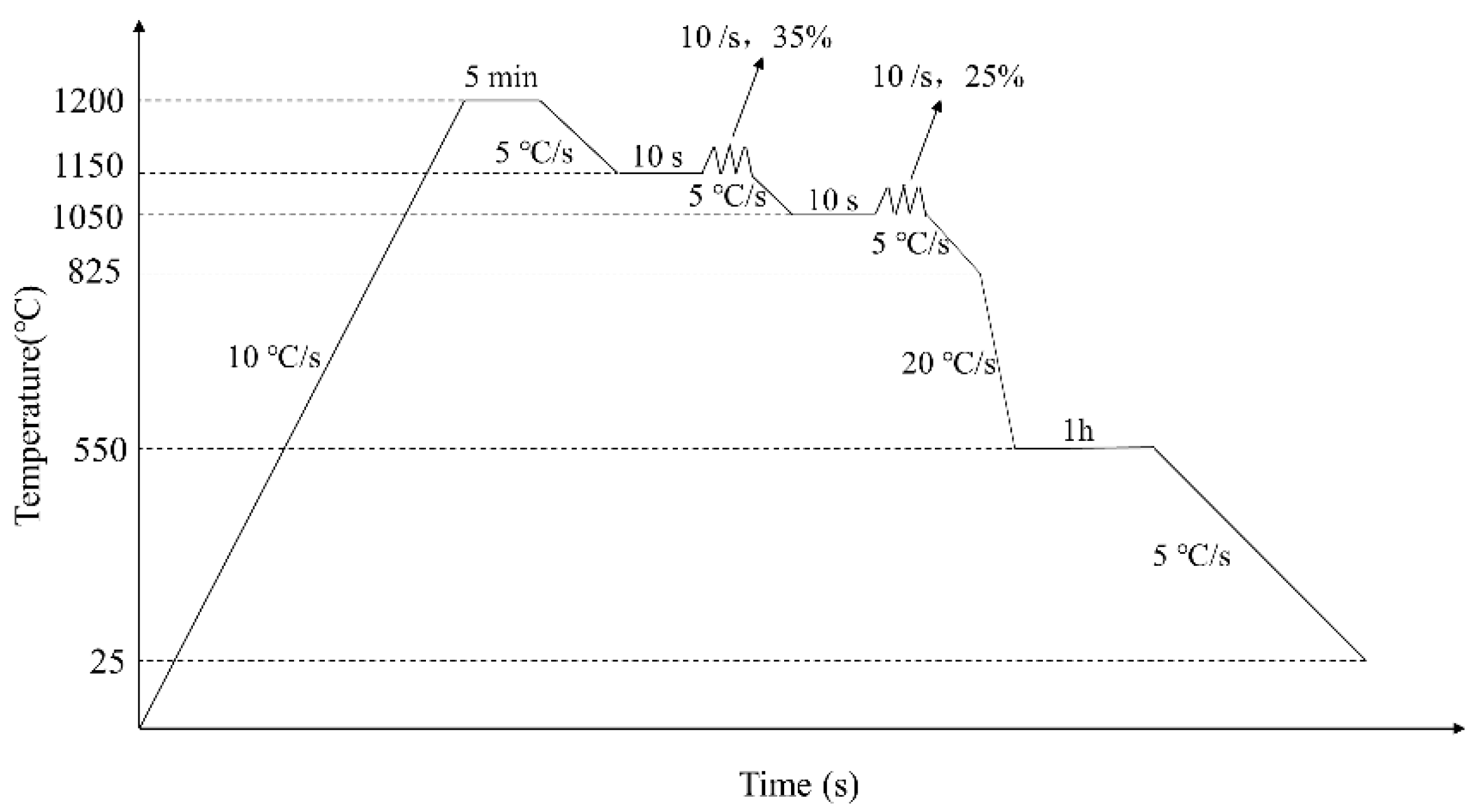
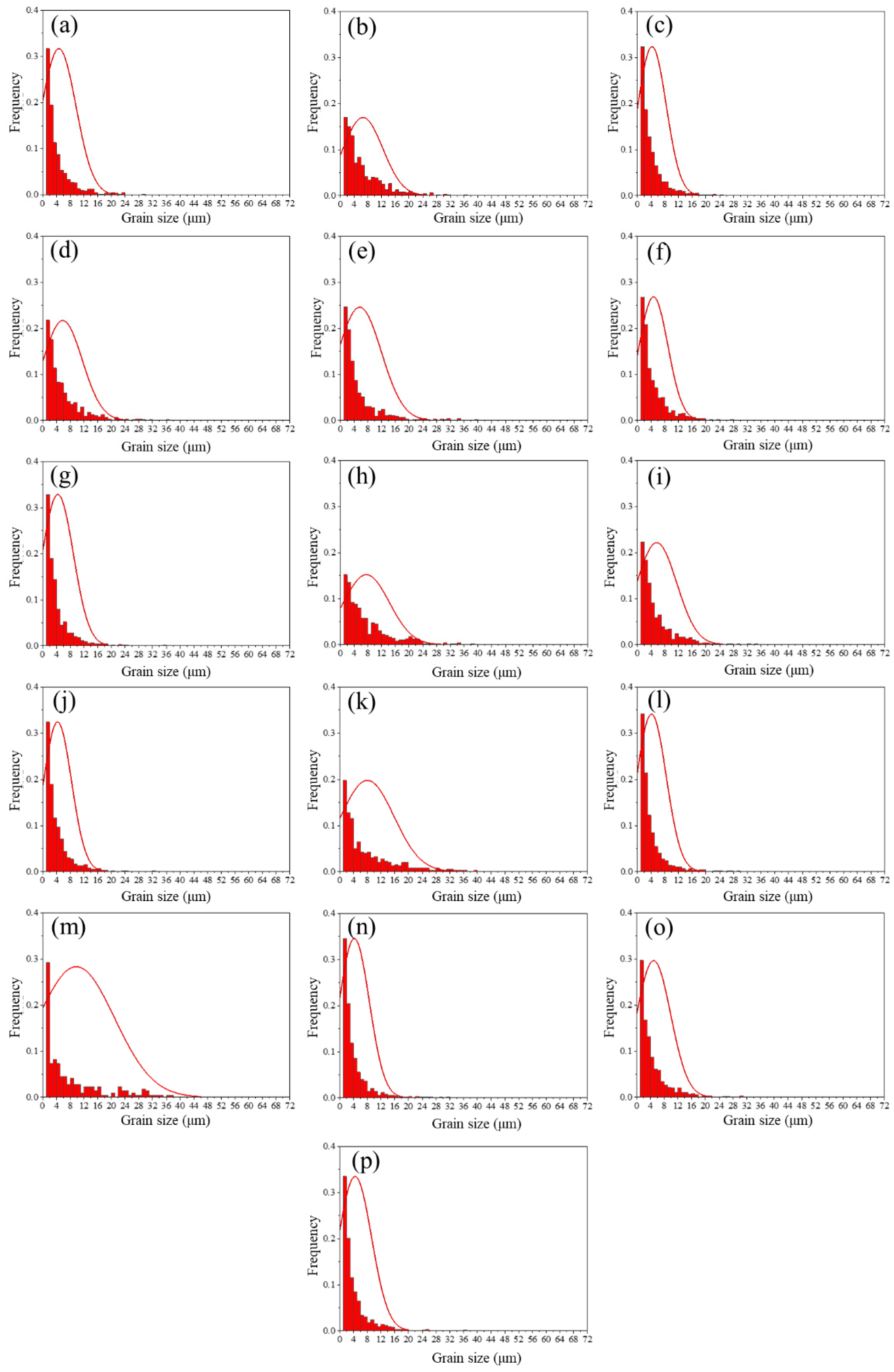

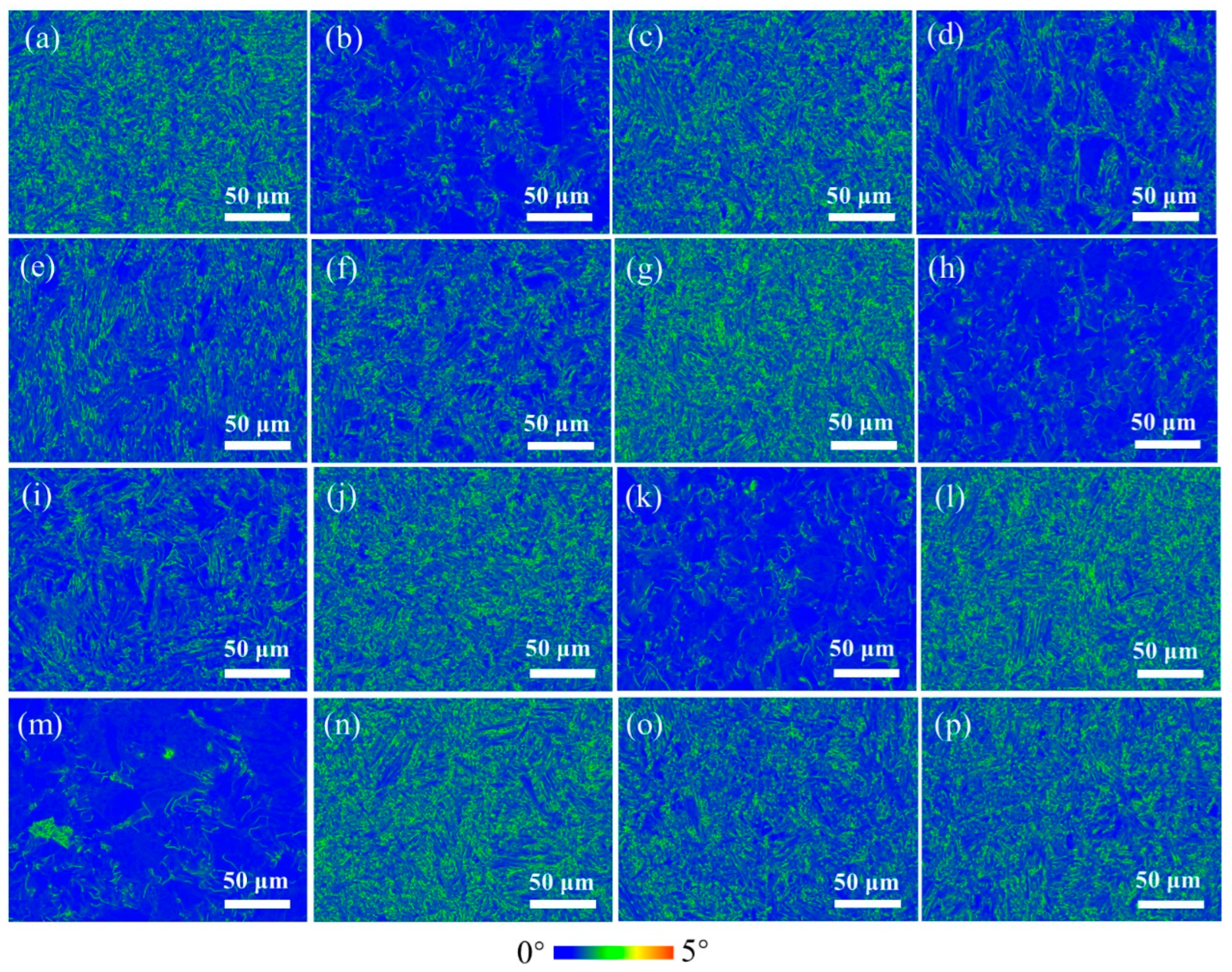
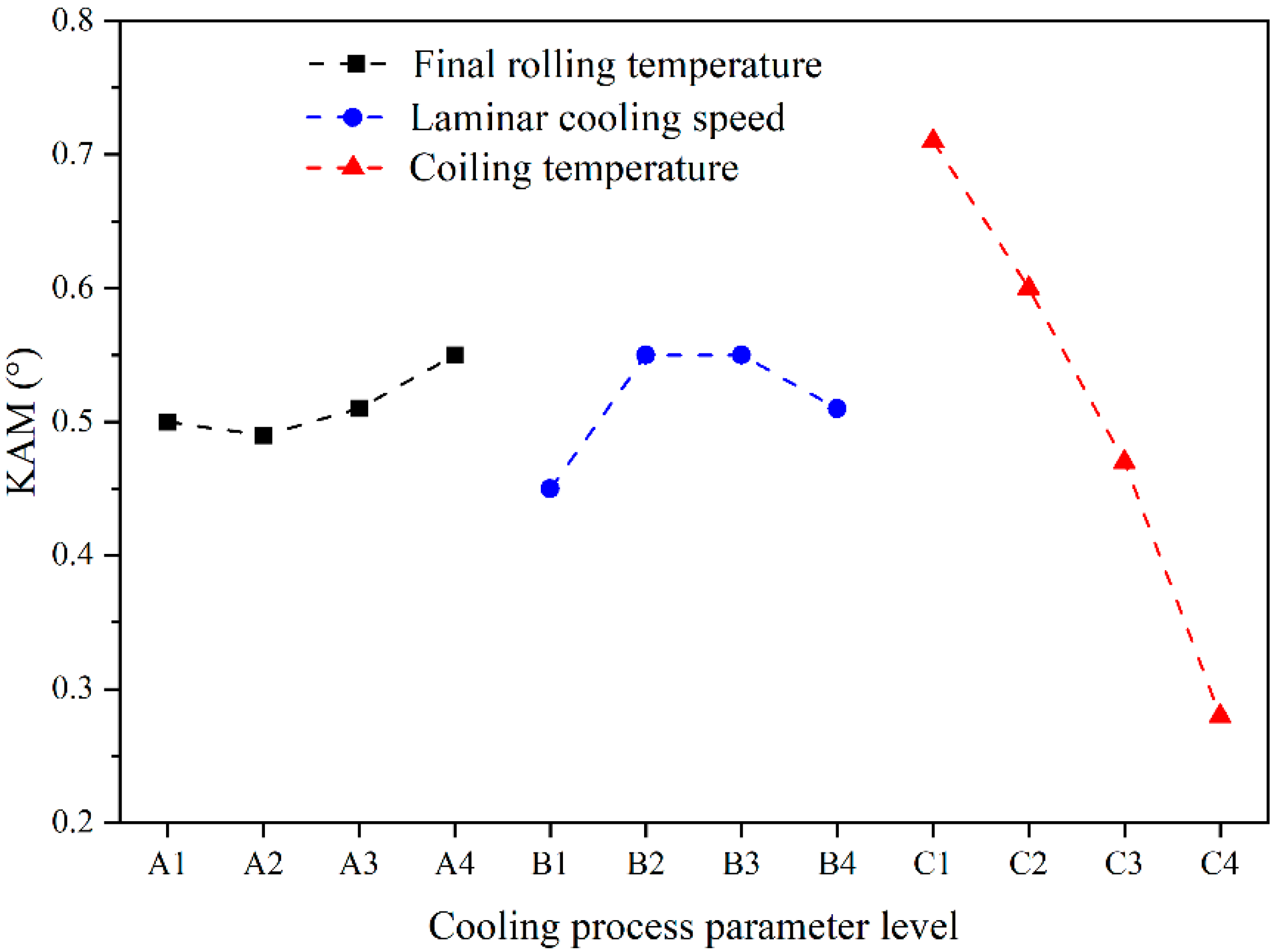
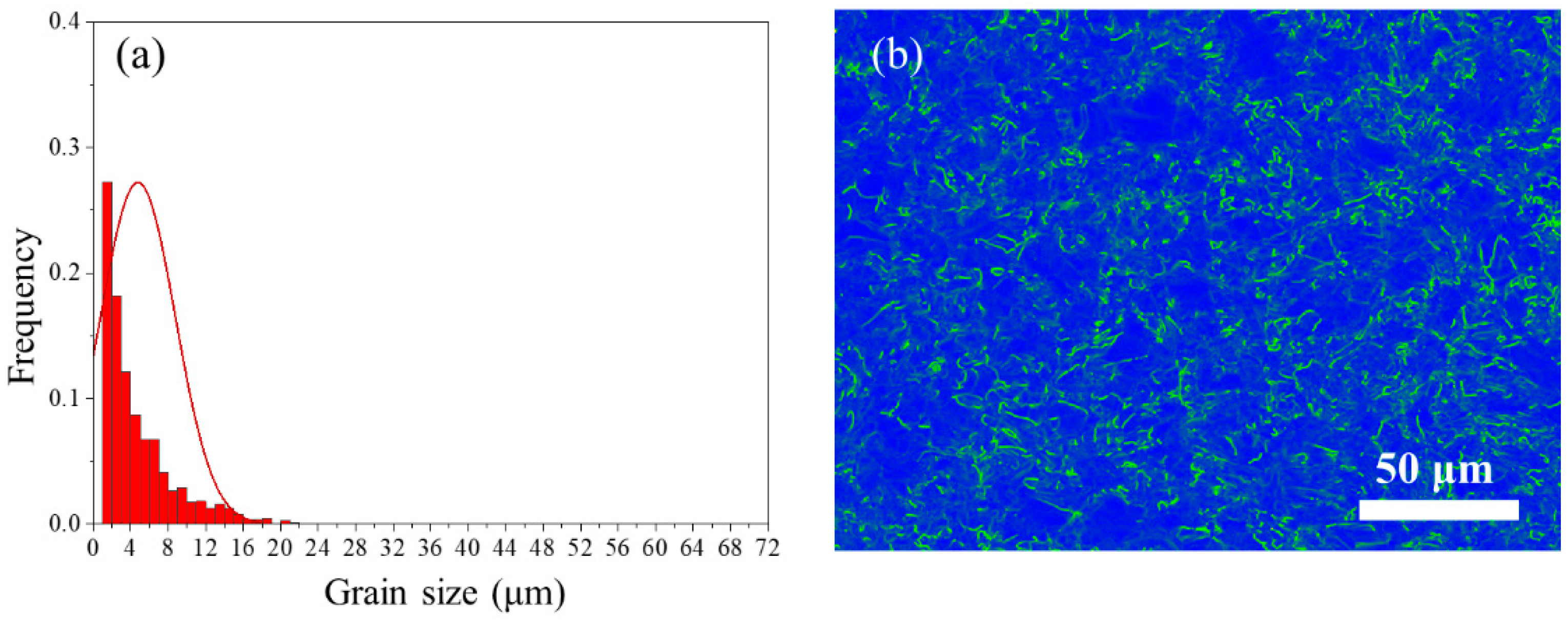
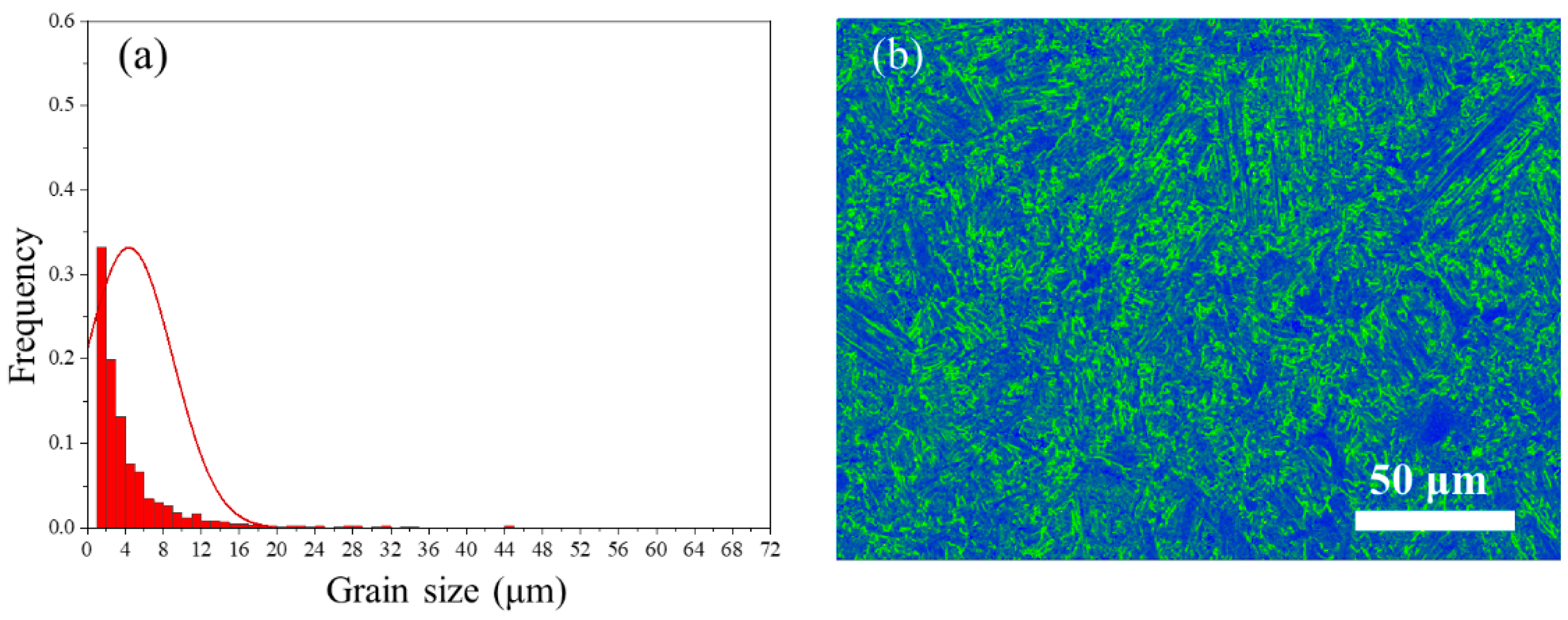

| Elements | C | Si | Mn | Al | Nb + V + Ti | Fe |
|---|---|---|---|---|---|---|
| Composition | 0.08 | 0.15 | 1.25 | 0.03 | 0.08 | Rest |
| Levels | Factors | ||
|---|---|---|---|
| A (°C) | B (°C/s) | C (°C) | |
| 1 | 825 | 20 | 550 |
| 2 | 850 | 30 | 575 |
| 3 | 875 | 40 | 600 |
| 4 | 900 | 50 | 625 |
| Numbers | Factors | Targets | ||
|---|---|---|---|---|
| A (°C) | B (°C/s) | C (°C) | D (μm) | |
| 1 | 825 | 20 | 550 | 4.7 |
| 2 | 825 | 30 | 625 | 6.6 |
| 3 | 825 | 40 | 575 | 4.3 |
| 4 | 825 | 50 | 600 | 5.8 |
| 5 | 850 | 20 | 575 | 5.6 |
| 6 | 850 | 30 | 600 | 4.7 |
| 7 | 850 | 40 | 550 | 4.4 |
| 8 | 850 | 50 | 625 | 7.6 |
| 9 | 875 | 20 | 600 | 5.7 |
| 10 | 875 | 30 | 575 | 4.3 |
| 11 | 875 | 40 | 625 | 8.1 |
| 12 | 875 | 50 | 550 | 4.2 |
| 13 | 900 | 20 | 625 | 9.8 |
| 14 | 900 | 30 | 550 | 4.3 |
| 15 | 900 | 40 | 600 | 5.0 |
| 16 | 900 | 50 | 575 | 4.5 |
| Factors | Mean Grain Size at Different Levels (μm) | Range (μm) | Sort | |||
|---|---|---|---|---|---|---|
| 1 | 2 | 3 | 4 | |||
| A | 5.4 | 5.6 | 5.6 | 5.9 | 0.5 | 3 |
| B | 6.5 | 5.0 | 5.5 | 5.5 | 1.5 | 2 |
| C | 4.4 | 4.7 | 5.3 | 8.0 | 3.6 | 1 |
| Numbers | Factors | Targets | ||
|---|---|---|---|---|
| A (°C) | B (°C/s) | C (°C) | E (°) | |
| 1 | 825 | 20 | 550 | 0.67 |
| 2 | 825 | 30 | 625 | 0.31 |
| 3 | 825 | 40 | 575 | 0.63 |
| 4 | 825 | 50 | 600 | 0.40 |
| 5 | 850 | 20 | 575 | 0.47 |
| 6 | 850 | 30 | 600 | 0.49 |
| 7 | 850 | 40 | 550 | 0.72 |
| 8 | 850 | 50 | 625 | 0.29 |
| 9 | 875 | 20 | 600 | 0.41 |
| 10 | 875 | 30 | 575 | 0.66 |
| 11 | 875 | 40 | 625 | 0.28 |
| 12 | 875 | 50 | 550 | 0.70 |
| 13 | 900 | 20 | 625 | 0.25 |
| 14 | 900 | 30 | 550 | 0.73 |
| 15 | 900 | 40 | 600 | 0.57 |
| 16 | 900 | 50 | 575 | 0.63 |
| Factors | Mean KAM at Different Levels (°) | Range (°) | Sort | |||
|---|---|---|---|---|---|---|
| 1 | 2 | 3 | 4 | |||
| A | 0.50 | 0.49 | 0.51 | 0.55 | 0.06 | 3 |
| B | 0.45 | 0.55 | 0.55 | 0.51 | 0.10 | 2 |
| C | 0.71 | 0.60 | 0.47 | 0.28 | 0.43 | 1 |
| Numbers | Experimental Data | Normalized Data | ||
|---|---|---|---|---|
| D (μm) | E (°) | D | E | |
| 1 | 4.7 | 0.67 | 0.911 | 0.125 |
| 2 | 6.6 | 0.31 | 0.571 | 0.875 |
| 3 | 4.3 | 0.63 | 0.982 | 0.208 |
| 4 | 5.8 | 0.40 | 0.714 | 0.688 |
| 5 | 5.6 | 0.47 | 0.750 | 0.542 |
| 6 | 4.7 | 0.49 | 0.911 | 0.500 |
| 7 | 4.4 | 0.72 | 0.964 | 0.021 |
| 8 | 7.6 | 0.29 | 0.393 | 0.917 |
| 9 | 5.7 | 0.41 | 0.732 | 0.667 |
| 10 | 4.3 | 0.66 | 0.982 | 0.146 |
| 11 | 8.1 | 0.28 | 0.304 | 0.938 |
| 12 | 4.2 | 0.70 | 1.000 | 0.063 |
| 13 | 9.8 | 0.25 | 0.000 | 1.000 |
| 14 | 4.3 | 0.73 | 0.982 | 0.000 |
| 15 | 5.0 | 0.57 | 0.857 | 0.333 |
| 16 | 4.5 | 0.63 | 0.946 | 0.208 |
| Numbers | Gray Correlation Coefficient | Gray Correlation Degree | |
|---|---|---|---|
| D | E | ||
| 1 | 0.848 | 0.364 | 0.606 |
| 2 | 0.538 | 0.800 | 0.669 |
| 3 | 0.966 | 0.387 | 0.676 |
| 4 | 0.636 | 0.615 | 0.626 |
| 5 | 0.667 | 0.522 | 0.594 |
| 6 | 0.848 | 0.500 | 0.674 |
| 7 | 0.933 | 0.338 | 0.636 |
| 8 | 0.452 | 0.857 | 0.654 |
| 9 | 0.651 | 0.600 | 0.626 |
| 10 | 0.966 | 0.369 | 0.667 |
| 11 | 0.418 | 0.889 | 0.653 |
| 12 | 1.000 | 0.348 | 0.674 |
| 13 | 0.333 | 1.000 | 0.667 |
| 14 | 0.966 | 0.333 | 0.649 |
| 15 | 0.778 | 0.429 | 0.603 |
| 16 | 0.903 | 0.387 | 0.645 |
| Factors | Mean Gray Correlation Degree at Different Levels | |||
|---|---|---|---|---|
| 1 | 2 | 3 | 4 | |
| A | 0.644 | 0.640 | 0.655 | 0.641 |
| B | 0.623 | 0.665 | 0.642 | 0.650 |
| C | 0.641 | 0.646 | 0.632 | 0.661 |
Disclaimer/Publisher’s Note: The statements, opinions and data contained in all publications are solely those of the individual author(s) and contributor(s) and not of MDPI and/or the editor(s). MDPI and/or the editor(s) disclaim responsibility for any injury to people or property resulting from any ideas, methods, instructions or products referred to in the content. |
© 2024 by the authors. Licensee MDPI, Basel, Switzerland. This article is an open access article distributed under the terms and conditions of the Creative Commons Attribution (CC BY) license (https://creativecommons.org/licenses/by/4.0/).
Share and Cite
Xue, R.; Fei, A. Multi-Objective Optimization of Low-Alloy Hot-Rolled Strip Cooling Process Based on Gray Correlation Analysis. Metals 2024, 14, 246. https://doi.org/10.3390/met14020246
Xue R, Fei A. Multi-Objective Optimization of Low-Alloy Hot-Rolled Strip Cooling Process Based on Gray Correlation Analysis. Metals. 2024; 14(2):246. https://doi.org/10.3390/met14020246
Chicago/Turabian StyleXue, Rundong, and Aigeng Fei. 2024. "Multi-Objective Optimization of Low-Alloy Hot-Rolled Strip Cooling Process Based on Gray Correlation Analysis" Metals 14, no. 2: 246. https://doi.org/10.3390/met14020246




